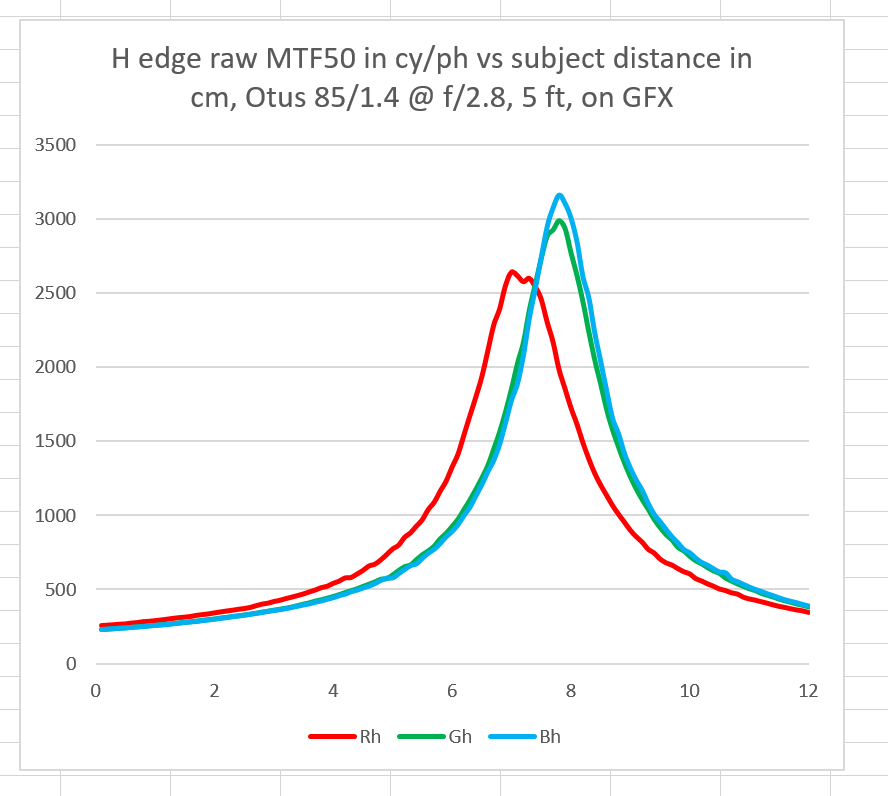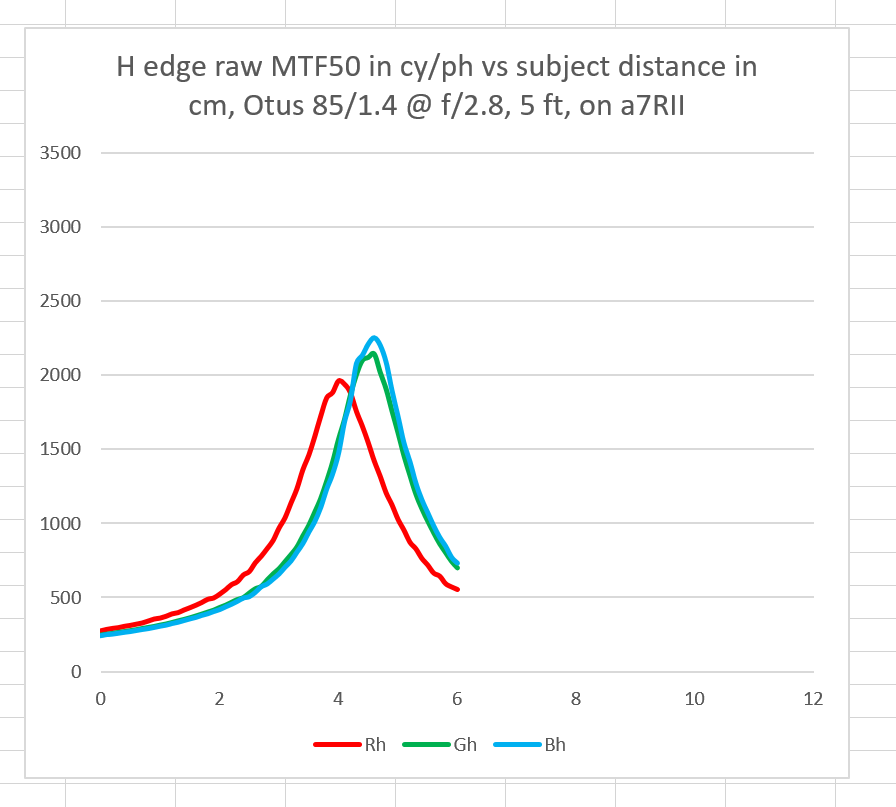This is the 30th in a series of posts on the Fujifilm GFX-50S. The series starts here.
There has been a lot of talk on the ‘net that the resolution differences between the a7RII and the Fuji GFX 50S don’t amount to much, so why suffer the increased hit on the pocketbook, loss of features, and increased weight to get the GFX?
Let me be clear that I see a big improvement in the resolution of the GFX, both with native and adapted lenses. Whether it’s enough to get you to pony up the cash for the GFX is a question only you can answer. Whether it’ll make a difference that you can see in the prints that you make with the field techniques that you use is another thing I can’t help you with. But there is a step up in resolution there.
I thought I’d do a quantitative test of on-axis sharpness with the same lens on the GFX and the a7RII. This will allow us to zero in on the differences in the sensor. There are three:
- The GFX sensor is 33×44 mm versus the a7RII’s 24×26 mm. This means that the physical picture height of the GFX is 37.5% taller than the A7rii.
- The GFX sensor is 8256 x 6192 pixels while the a7RII sensor is 7952 x 5304 pixels. This means that the picture height in pixels of the GFX is 17% more than the A7rii.
- The a7RII has nearly 100% fill factor because of its back-side illuminated (BSI) construction and the way its microlenses are designed. The Fuji has less coverage, since the microlenses are deliberately made small than the pixels in the sensor. This will increase sharpness at the cost of more aliasing.
You probably noticed that I normalized by picture height, not diagonal. That’s because I usually prefer images between 4:3 and 1:1 in aspect ratio. If you like long skinny images, you might normalize by the picture width; that will give results more favorable to the a7RII.
I set up my motorized rail and backlit razor blade sharpness rig, set the Otus to 5 feet and F/2.8, set both cameras to base ISO, turned EFCS on in both cases, and made two series of exposure runs with 1 mm steps between exposures. I looked at the resolution as measured by MTF Mapper in each of the raw planes as decoded, but not demosaiced, by dcraw. The metric for sharpness that I chose was MTF50 in cycles per picture height.
Here’s what I got:
The green channel in the a7RII case peaks at 2144 cy/ph. For the GFX, the corresponding number is 2988. That’s a 39% improvement. The red channel improves by 32%, and the blue channel by 40%. I think the fact that the ratios are different may have something to do with the dye spectra in the tow cameras color filter array (CFA) being different. Not that the blue channel is the sharpest for the GFX, while the green channel is the winner for the a7RII. Another possible source of difference is the sensor stack thickness and location.
Here’s the Imatest summary of the green raw channel of the GFX image in which that channel was the sharpest:
The reason that the MTF curve looks so flat is that the G1 channel image has only a quarter the pixels and half the resolution of the entire raw image.
The sharpest green channel image with the a7RII looks like this:
Even on a per-pixel basis, the a7RII image is slightly less sharp. Some of that has to do with the fact that the a7RII pitch is less. Some probably has to so with the proportionally smaller microlenses in the GFX. I have no way of sorting out which is which.
If we let dcraw demosaic those two images with the Imatest default settings, here’s what we get:






Jack Hogan says
In a perfect world we would expect the ratio of MTF50 in lp/ph from two perfect cameras with the same perfect lens to approximately reflect the ratio of their sensor heights, a 37.5% difference favoring the GFX in this case as you indicate. As you show we get close to this with your MTF Mapper readings (it looks like the peak of the red channel was missed so I replaced that outlier with an eyeballed curve fit ): 39%, 39%, 40% for RGB resp.
Many reasons why these figures could come out slightly higher in favor of the GFX, one of them could be its smaller pixel aperture (Front Side Illumination and truncated microlens vs BSI and full microlens in the a7RII). You also mention differences in the Spectral Sensitivity Functions of the CFAs and I agree with. But the relative effects are expected to be small.
Note however that the ratios from the Imatest readings are not even in the same ballpark.
Jack
JimK says
Apples to oranges on the Imatest readings, I think. I only looked at the green raw channel in Imatest. Not sure what color space their demosaiced result is in, or what WB.
JimK says
Jack, that 37.5% improvement with a perfect lens would reflect the diffraction pickup. The GFX also has more pixels top to bottom, and, as you point out, closer to a point sampler.
Jack Hogan says
Yeah, on second thought poor wording and too many simplifying assumptions that may not hold on my part. I am probably incorrectly assuming that scene and lens parameters are exactly the same for the two captures and system performance at f/2.8 in the center is limited by spherical+defocus OPD aberrations: about 2200/24 = about 3000/32.9 = about 91 lp/mm. In that case what counts most for resolution in terms of lp/ph is the ratio of the sensor heights. Things may be different at f/4-5 where OPD is much lower (to the second, fourth and higher powers) because of the smaller exit pupil and diffraction is not dominant yet.
Jack
JimK says
Golly, Jack, you’ve learned a lot about lens design. I may have to pick your brain sometime.
Rishi Sanyal says
Jim – thanks for all the interesting work. Very informative.
Jack – you wrote: “In a perfect world we would expect the ratio of MTF50 in lp/ph from two perfect cameras with the same perfect lens to approximately reflect the ratio of their sensor heights, a 37.5% difference favoring the GFX in this case as you indicate.”
I’m a little confused – isn’t that only for sensors of the same resolution (say, same number of vertical pixels, in this case?). Surely a 44x33mm 100MP sensor would have a higher expected MTF50?
If not, please help me understand, and many thanks in advance!
JimK says
Rishi, see Jack’s and my discussion on this issue elsewhere in these comments. He may respond directly to your post. Thanks for stopping by.
JimK says
Here’s a comment that Jack Hogan made that got lost in the move to the new server:
Hi Jim, good test, very interesting results and good to see that the readings reflect expectation from Theory.
I agree that different CFA spectral sensitivity functions should contribute to obtaining slightly different results from expectations given the same lens on the two cameras. I think for whatever reason the Red channel peak was missed in the GFX series. If you eliminate the outlier and fit the peak it seems that you would get something close to the expected 37.5% improvement compared to the a7RII.
Why do you say: “Note that the blue channel is the sharpest for the GFX, while the green channel is the winner for the a7RII”? The winners both look blue to me.
Jack
JimK says
Jack, thanks for the catch on the green and blue peaks. Fixed now.